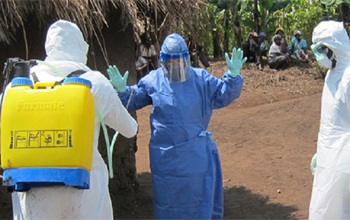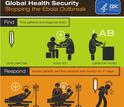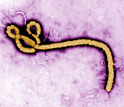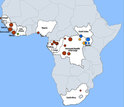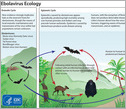Hola amigos: AL VUELO DE UN QUINDE EL BLOG., la Agencia Espacial NASA, nos informa sobre sus estudios en la Antártica sobre que comienza Sexto Año de Airborne Antártida Estudio Cambio de Hielo. Ellos dicen..."NASA está llevando a cabo su sexto año consecutivo de vuelos de investigación Operación IceBridge sobre la Antártida para estudiar los cambios en la capa de hielo del continente, glaciares y hielo marino. Campaña aérea de este año, que comenzó su primer vuelo la mañana del jueves, volverá a examinar una sección de la capa de hielo de la Antártida que hace poco se encontró que en un declive irreversible.........
Para las próximas semanas, los investigadores volarán a bordo de aviones de investigación de la NASA DC-8 de Punta Arenas, Chile. Este año también marca el regreso de la Antártida occidental tras la campaña de 2013 con base en la estación McMurdo de la Fundación Nacional de Ciencia.....
NASA is carrying out its sixth consecutive year of Operation IceBridge
research flights over Antarctica to study changes in the continent’s ice sheet,
glaciers and sea ice. This year’s airborne campaign, which began its first
flight Thursday morning, will revisit a section of the Antarctic ice sheet that
recently was found to be in irreversible decline.
For the next several weeks, researchers will fly aboard NASA’s DC-8 research
aircraft out of Punta Arenas, Chile. This year also marks the return to western
Antarctica following 2013’s campaign based at the National Science Foundation’s
McMurdo Station.
“We are curious to see how much these glaciers have changed in two years,”
said Eric Rignot, IceBridge science team co-lead and glaciologist at the
University of California, Irvine and NASA’s Jet Propulsion Laboratory (JPL) in
Pasadena, California.
IceBridge will use a suite of instruments that includes a laser altimeter,
radar instruments, cameras, and a gravimeter, which is an instrument that
detects small changes in gravity. These small changes reveal how much mass these
glaciers have lost. Repeated annual measurements of key glaciers maintains a
long-term record of change in the Antarctic that goes back to NASA’s Ice, Cloud
and Land Elevation Satellite (ICESat) which stopped collecting data in 2009.
IceBridge researchers plan to measure previously unsurveyed regions of
Antarctica. One example is a plan to look at the upper portions of Smith Glacier
in West Antarctica, which is thinning faster than any other glaciers in the
region. The mission also plans to collect data in portions of the Antarctic
Peninsula, such as the Larsen C, George VI and Wilkins ice shelves and the
glaciers that drain into them. The Antarctic Peninsula has been warming faster
than the rest of the continent.
“The Antarctic Peninsula is changing fairly rapidly and we need to be there
to capture that change,” said Michael Studinger, IceBridge project scientist at
NASA’s Goddard Space Flight Center in Greenbelt, Maryland.
The mission also will collect data on Antarctic sea ice, which recently
reached a record high coverage. This contrasts with declining sea ice in the
Arctic and is due do a variety of factors such as changing wind patterns.
Antarctic sea ice coverage is slightly above average and the growth varies from
one part of Antarctica to another. For example, ice cover in the Bellingshausen
Sea has been decreasing while ice in the nearby Ross Sea is growing.
“There are very strong regional variations on how sea ice is changing,” said
Nathan Kurtz, a sea ice scientist at Goddard. These regional trends together
yield a small increase, so studying each region will help scientists get a
better grasp on the processes affecting sea ice there.
In addition to extending ICESat’s data record over land and sea ice,
IceBridge will also help set the stage for ICESat-2 by measuring ice the
satellite will fly over. One of IceBridge’s highest priority surveys is a
circular flight the DC-8 will fly around the South Pole at 88 degrees south
latitude. This latitude line is where all of ICESat-2’s orbits will converge in
the Southern Hemisphere. Measuring ice elevation at these locations will help
researchers build a time series of data that spans more than a decade and
provide a way to help verify ICESat-2’s data.
IceBridge’s Antarctic field campaign will run through late November. The
IceBridge project science office is based at Goddard. The DC-8 research aircraft
is based at NASA’s Armstrong Flight Research Center’s facility in Palmdale,
California.
For more about Operation IceBridge, visit:
NASA monitors Earth's vital signs from land, air and space with a fleet of
satellites and ambitious airborne and ground-based observation campaigns. NASA
develops new ways to observe and study Earth's interconnected natural systems
with long-term data records and computer analysis tools to better see how our
planet is changing. The agency shares this unique knowledge with the global
community and works with institutions in the United States and around the world
that contribute to understanding and protecting our home planet.
For more information about NASA's recent Earth science activities, visit:
NASA
Guillermo Gonzalo Sánchez Achutegui

